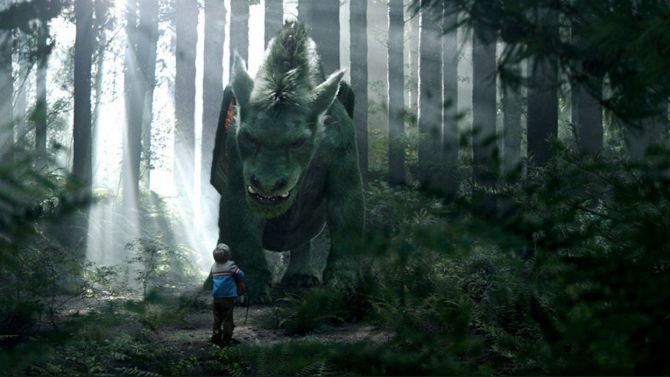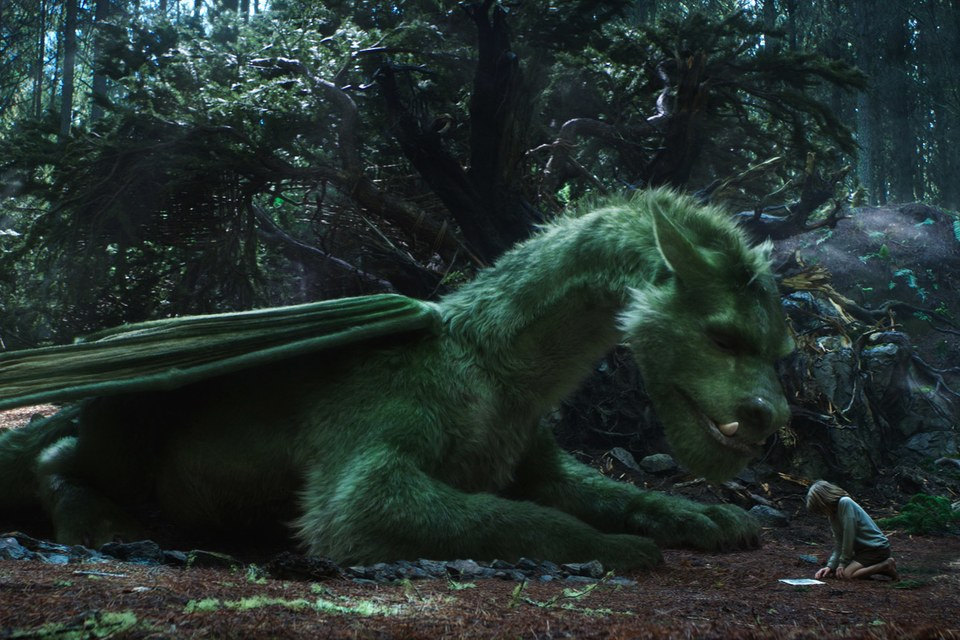 ‘Ain’t Them Bodies Saints’ director David Lowery puts a totally new spin on the Disney classic, inviting audiences to believe in a boy and his pet dragon.
‘Ain’t Them Bodies Saints’ director David Lowery puts a totally new spin on the Disney classic, inviting audiences to believe in a boy and his pet dragon.
The original “Pete’s Dragon” is, without a doubt, one of the most eccentric entries in the Disney canon — an almost hallucinatory live-action/animation hybrid, crammed wall-to-wall with singing, about a 9-year-old orphan and his magical pink-and-green sidekick, whom practically nobody else can see. One had to be either Pete’s age or a puff-draggin’ enthusiast to appreciate the trippy film when it came out, and time has only rendered the movie that much weirder — which makes it a far better candidate for a Mouse House remake than many of the studio’s more universally beloved classics.
Reimagined nearly four decades later, Disney’s in-name-only “Pete’s Dragon” reboot trades the earlier version’s goofy cartoony sensibility for a sort of stylized realism, one in which everything looks a bit too good to be true (including the stunning Weta Digital-animated dragon himself), and yet the story is geared in such a way that we desperately want to believe. The result is one of the year’s most delightful moviegoing surprises, a quality family film that rewards young people’s imaginations and reminds us of a time when the term “Disney movie” meant something: namely, wholesome entertainment that inspired confidence in parents and reinforced solid American values. It’s old-fashioned in all the right ways, from the patient pace at which the story unfolds to the appearance of Robert Redford as its grizzled narrator — the only other person to believe Pete (Oakes Fegley), having once witnessed the Millhaven dragon with his own eyes.
Unlike other higher-stakes remakes in the Disney catalog, for which the studio tapped such “name” directors as Tim Burton (“Alice in Wonderland”) and Jon Favreau (“The Jungle Book”), this assignment fell to a relatively unproven young indie filmmaker, David Lowery, whose “Ain’t Them Bodies Saints” debuted at the Sundance film festival in 2013. A lyrical outlaw romance that borrowed liberally from the playbooks of Terrence Malick and Robert Altman, “Saints” was Lowery’s third feature (though hardly anyone knows his earlier work). In many ways, this project — mounted with the confidence and clarity of vision of an old master — feels like as great a step up for Lowery as the “Jurassic World” gig did for “Safety Not Guaranteed” helmer Colin Trevorrow last year. Both cases represent a tide shift in Hollywood studio fare as producers make an effort to ground big-budget, effects-heavy films in the sort of rich character drama alive and well in American independent cinema.
So, while a cutting-edge CG dragon may be the reason audiences pay to see “Pete’s Dragon,” the film’s true appeal lies in its texture and the timeless human moments at the film’s core. Featuring perhaps the darkest opening/backstory of any Disney movie since “Bambi” — and one that could fairly be viewed as Bambi’s revenge on the humans who shot his mother — the film opens with Pete paging through a picture book in the back seat of the family station wagon when a deer bolts from nowhere and forces the car off the road, killing Pete’s parents in the process. Chased by wolves deep into the forest, Pete comes face to face with a giant green, doglike creature (closer to “The Neverending Story’s” Atreyu than the daffy, Don Bluth-animated dragon of the original), whom he decides to call Elliot.
Skip forward six years and Pete and Elliot have effectively domesticated one another — assuming that “domesticated” is the right word for a feral child and his cave-dwelling best friend. As in DreamWorks Animation’s splendid “How to Train Your Dragon” series, the filmmakers have studied what endears humans to their pets and amplified those qualities into the realm of fantasy. Blending the heartland feel of composer Daniel Hart’s folk-inflected score with gorgeous widescreen vistas of virgin forest (in which New Zealand doubles for the Pacific Northwest), Lowery and DP Bojan Bazelli take audiences along for vicarious 3D rides high above the clouds, while also leaving room for games of fetch and hide-and-seek, which are all the more challenging when one party has the power of invisibility.
While never outright preachy on the subject, the script by Lowery and co-writer Toby Halbrooks has an eco-friendly subtext as green as its title character. The first human Pete observes is a forest ranger named Grace (Bryce Dallas Howard), who is tracking endangered species in order to protect their habitat from a lumber company operated by her fiancé (Wes Bentley) and his gung-ho brother Gavin (Karl Urban). In a charming moment of mutual curiosity between Pete and Grace’s soon-to-be daughter-in-law, Natalie (Oona Laurence), the scruffy 10-year-old reveals himself, only to be brought into town and treated like a sideshow attraction — which is nothing compared to the way Millhaven will react to the discovery of his dragon a short time later.
As Pete reintegrates into a loving family and Gavin — a red-blooded Second Amendment advocate who sees Elliot as his ultimate hunting trophy — sets out to capture a creature that never so much as raided a local chicken coop, a movie that won us over by trusting its audience and showing, rather than spelling everything out, ultimately proves unable to resist the formula of all such stories. But who goes into a Disney remake looking for originality anyway? A sturdy and sensitively told entry in the magical-best-friend genre, “Pete’s Dragon” joins a long and beloved tradition that encompasses everything from practical-effects classics “E.T.: The Extra-Terrestrial” and “Harry and the Hendersons” to Disney’s recent visual effects marvel, “The BFG.”
Lowery owes no small debt to Spielberg here, paying homage in various ways — as when characters stare wide-eyed at the off-screen dragon — and though the ambition isn’t as giant, he has actually crafted the better film, one that succeeds in bringing audiences to the brink of tears in all the right moments. (Don’t worry, no dragons were harmed in the making of this film.)
While Fegley convincingly interacts with his nonexistent co-star, it is his dragon who delivers the film’s most impressive performance — for which Weta visual effects supervisor Eric Saindon and his team deserve credit, putting care into everything from Elliot’s emerald-green fur (a nice surprise for a species more often thought to be scaly) to the wobbly way he flies, much as an enormous dog strapped to a hang glider might struggle to keep his balance aloft. The dragon is by far the greatest innovation over the original, which cut corners by making the hand-drawn character “invisible” for nearly half the movie: Here, Elliot doesn’t just look believable, but he sounds it as well, with every breath and sigh adding credibility to a creature we desperately want to be real.


